We’ve all heard someone say “The acoustics in here are fantastic!” or “I can’t understand a thing, the acoustics in here are [censored].” What exactly does good acoustics sound like? Is it simply an observation of sound quality, volume, or pitch? Is there really a difference between good acoustics and top-notch soundproofing? What materials are best suited for acoustic improvement? Don’t worry. We’ll get there.
We’ll dig into those questions and more as we run through the basics of acoustics — and the benefits of improving them in your home, on the road, and at the workplace. As anyone who’s spent a little time in a gym with thunderous echoes will tell you, the sounds you hear impact your quality of life.
Have questions about your application? Give us a call at 1-800-679-8511 to speak to an acoustics professional.
We’ll start our lesson on acoustics by making one clear distinction — acoustic materials do not block sound. Sticking acoustic foam to the walls in your apartment will not keep the noise from your neighbor’s surround-sound entertainment system out of your living room. Acoustic materials do not soundproof. If you need help blocking sound, visit our soundproofing materials and guide page.
So what do acoustic materials do? The simplest way to think about it is this: while sound blockers keep noise OUT of a given space and acoustic materials improve sound INSIDE of a space. They prevent echoes and unpleasant reverberation while improving the quality of sound that you want to hear.
That’s why acoustic foam is common in recording studios. The sound waves from the musicians playing reaches the walls of the booth and instead of bouncing back and forth across the microphone, it’s absorbed by the foam on the walls. Less reverberations makes for a much clearer, cleaner sound. The same is true for movie theaters; just think of the last big blockbuster movie you saw. You probably didn’t notice the sound absorbing panels hung on the walls — without those fabric wrapped panels, the sounds of that loud action scene carry over into the dialogue, and you’re as lost as Leo DiCaprio in Inception. And the last thing that movie needs is garbled speech to help you keep up with the plot.
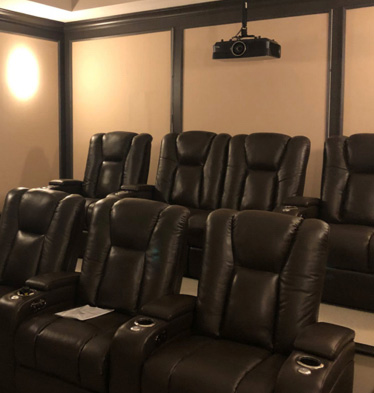
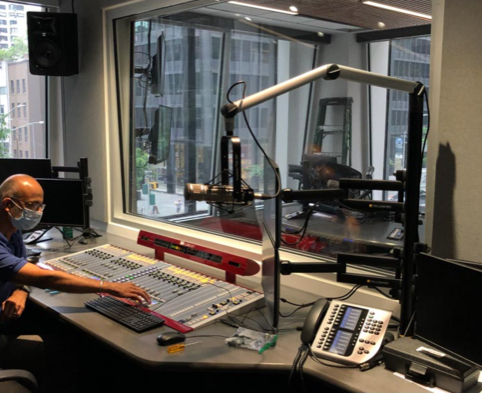
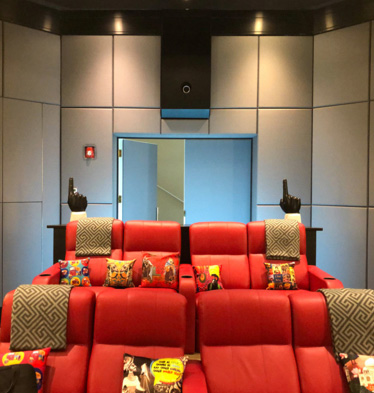
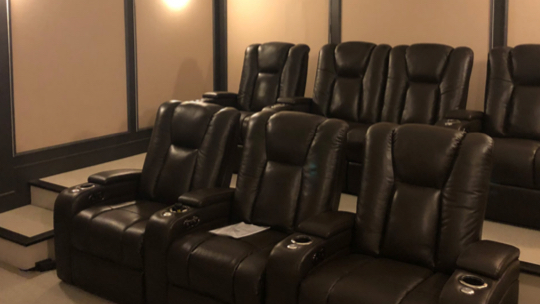


Sound absorption turns sound waves into heat by transforming the relatively uniformly-patterned sound waves into random, disordered movement of molecules. Think of when you heat something in the microwave — it warms up by forcing the food’s molecules to bounce around randomly. Acoustic materials cause ordered sound movement to bounce in random directions within the foam, which generates a bit of heat and reduces the sound wave's energy.
Like absorption, sound diffusion disrupts the path of sound waves. The difference is, sound diffusion is the process of spreading out sound waves throughout a space evenly so as to lessen their energy. Whereas a piece of acoustic foam board will absorb sound, a curved diffuser with a hard surface will distribute the sound throughout the room. Your typical room or commercial space doesn’t need to worry about diffusion. It’s really only relevant to broadcast studios, recording studios, and rooms with live performances.
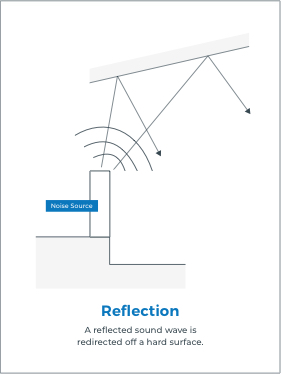
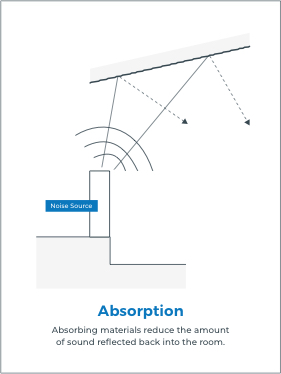
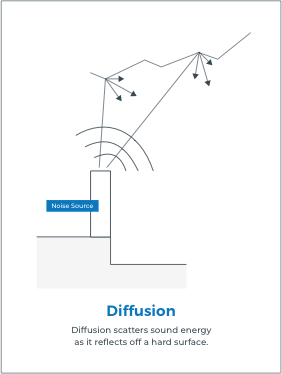
Soundproofing creates barriers. By building dense, airtight barriers between spaces, you can prevent the passing of sound waves from one space to the other (at least so only a negligible amount of sound is heard).
Soundproofing is effective when it achieves a high level of sound isolation, which can be measured by the sound transmission class (STC) rating. STC rating tells you how much sound a particular construction or material can stop. For reference, a wall with an STC rating of 25 won’t even block the sound of normal speech. Every 5 points of STC rating beyond that will make a clearly noticeable difference, and then once you get to where your wall construction is over 60, you’re effectively soundproof.
Whereas barrier materials are measured with STC ratings, sound absorbing material is measured by noise reduction coefficient (NRC). NRC tells you how much sound a material can absorb on a scale from 0 to 1, with 0 meaning the material absorbs no sound and 1 meaning the material absorbs all sound.
Another concept to understand is reverberation time. Reverberation time (RT60) measures the amount of time after the source of the sound has stopped that it takes for that sound to reduce 60 decibels. The average person conflates reverb vs echo as one and the same, but if you're reading about the details of acoustics... you aren't the average person. Still, we typically use the two terms interchangeably to communicate basic concepts. So put another way, RT60 measures how long the echoes last, or how long a sound wave bounces around inside a space.
After getting familiar with these concepts, you’ll understand better why we focus on using sound absorption materials for echo control and improving speech intelligibility, not blocking sound. Adding sound absorbers is particularly effective in rooms with lots of hard surfaces, as you get diminishing returns as you continue to add absorption. The key is to get to the right amount for the sound quality needed by the space. For example, big rooms with high ceilings and lots of hard surfaces absolutely require additional sound absorbers for good sound quality. Think of a convention center, an auditorium, or a house of worship— where without sound absorption, noise continuously builds up, and you can no longer hear the speaker. Acoustic materials are the answer for better speech intelligibility and sourcing. By sourcing, I mean that you’re able to tell where exactly the sound is coming from. Speakers are much easier to understand when you hear them directly instead of hearing a wall reflecting the sound of their voice.
Earlier we mentioned the diminishing returns you see from adding acoustic materials for more sound absorption. As a quick rule, doubling the amount of acoustic material will reduce noise by 3 decibels in the average room and cut reverberation time in half. It takes at least a doubling of materials to achieve a noticeable sound reduction. But you can only double so many times before you run out of space to stand!
Let’s say one of the kids is off to college and you decide to convert their bedroom into a home theater (great idea!). Where do you start? The first step is to measure the full space. In the acoustics world, rooms with measurements that are multiples of each other make things more difficult. For example, a 10 x 10 x 10 room will naturally have bad acoustics. The same goes for a room that’s 10 x 20 x 10.The golden ratio for acoustics is 1 (height) x 1.6 (width) x 2.3 (length. Achieving this ratio is not always practical (or even possible), but it knowing it on the front-end is helpful with acoustics for new construction.
Once you have measurements, it’s time to test the space. Evaluate what your challenges will be — will the room require sound absorption or sound blocking? Do you need to keep outside noise out of the space or is the bigger problem how to stop echo in a room? The biggest mistake folks can make is solving the wrong problem, which leads to lots of effort and nobody any better off.
Next, do some due diligence on placement and materials. Music rooms require different panel placement than home theater acoustic panels and nursery rooms require a different treatment than an outdoor garage. For a professional space, you’re almost always looking at acoustic panels, because they look better, are more durable, and perform twice as well per volume. Acoustic panels can get complicated for large rooms, rooms with tall ceilings, or unusually designed spaces, but there are a few rules of thumb for standard rooms:
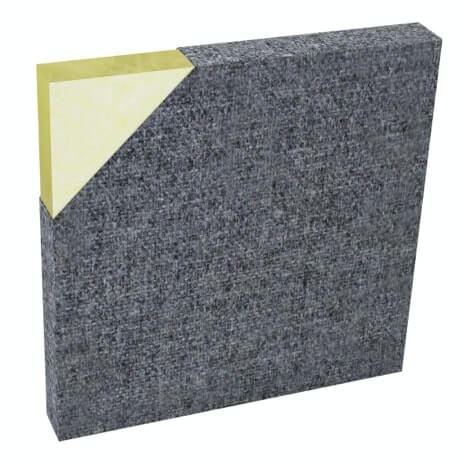
Multiply length x width of the room to get the square footage. Multiply that square footage by 40%. That’s how many square feet of acoustic panels you need for a small to medium sized room. While we acoustics experts may hem and haw about the exceptions, the 40% rule is good enough for your typical home office, conference room, or other standard space.
Stagger placement of your acoustic panels so they aren’t all bunched up. Acoustic panels should be on at least 2 adjacent walls, although 3 or 4 walls is fine if that looks best aesthetically. Best practice is to have at least 12” of space between panels. As low as 3” is fine, and won’t reduce performance too much.
Adding a bookshelf to your wall will certainly introduce a diffuser to the space, but the problem is, you have no idea what the effect is. It’s difficult to measure how effective a material is at reducing sound when its surfaces are irregular. The goal of acoustics is to eliminate variables and get a mathematically-sound solution. And no, books do not absorb sound.
Unfortunately (or fortunately?), just about all egg cartons are good for is holding eggs. The foam used in egg cartons is too thin to serve as a blocker and though their shape is similar to many acoustic foams, the material does not actually absorb sound.
Curtains have some very limited value as sound absorbers if they are particularly thick. But in general, I don’t care what kind of drapes you have when determining how to improve the acoustics of a room. The impact is negligible. Even more dubious is people buying curtains to BLOCK sound. If you’re going to try and block sound, remember the principles of soundproofing! The material needs to be dense, limp, and airtight. Get HEAVY curtains with a high STC rating, and then install them as airtight as you can. If you have massive gaps at the edges, sound is going to travel right around those new curtains you spent up for.
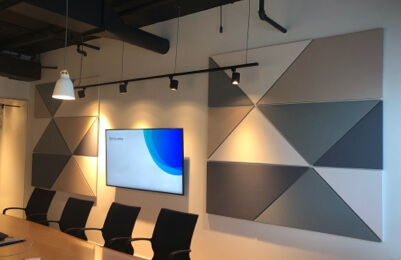
Acoustic panels are what you probably imagine when I say “acoustic materials.” They are square blocks of fiberglass-based or poly-based foam, often 2 inches thick and around 24 inches wide. Acoustic panels have commercial and residential uses, for everything from personal music studios to school cafeterias. We have an awesome set of designer quality, fabric wrapped panels you should take a look at.
Shop Products →
Acoustic foam is made of fiberglass, polyurethane foam, polyester, or melamine foam. It’s sold in a variety of shapes and sizes, commonly in a wedge, pyramid, or eggcrate pattern. Different shapes serve different purposes and it’s not uncommon to see several varieties in one space. We like to use melamine foam, because it’s Class A fire rated and a really good sound absorber.
Shop Products →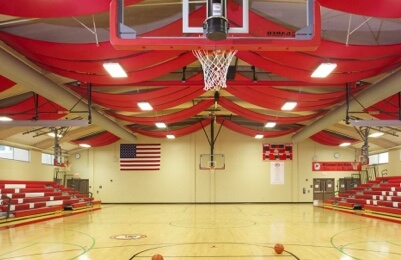
Acoustic baffles are absorptive panels that are often hung from high ceilings. Baffles are commonly used for office noise reduction as well as in schools, libraries, and other public places. Baffles are great for improving sound quality in large, open spaces.
Shop Products →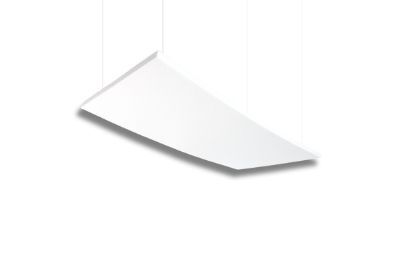
Acoustic clouds are absorptive panels typically hung parallel to the ceiling to help cover major reflection points and reduce echo and reverb in a room. Clouds are often hung in large spaces like schools and offices, and above mixing consoles as part of a recording studio acoustic treatment to control reflective sound. Acoustic clouds are a popular choice for sound control in all kinds of spaces.
Shop Products →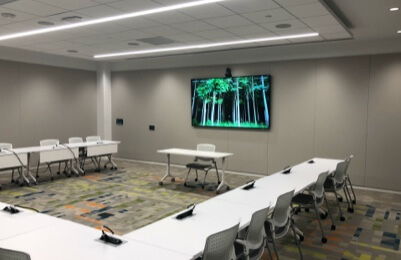
Acoustic ceiling tiles are mineral-fiber tiles usually measuring less than an inch thick. They’re most often installed in homes and offices as a relatively inexpensive solution to poor indoor acoustics by replacing standard ceiling tiles in a dropped ceiling.
Shop Products →There you have it! We covered everything from the difference in soundproofing and acoustics to the most common types of acoustic materials. A lot of science and math goes into the spaces we often take for granted every day. No matter your project, just remember the key to improving the sound quality in your home or workplace is to understand what challenge you’re facing and attacking the problem at the source. The results will be worth it.